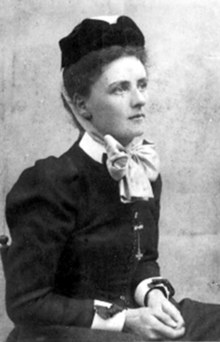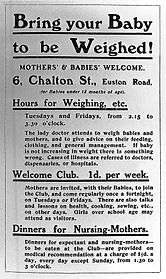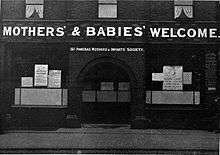Alys Pearsall Smith
Alyssa Whitall "Alys" Pearsall Smith (21 July 1867 – 22 January 1951) was an American-born Quaker relief organiser and the first wife of Bertrand Russell. She chaired the society that created an innovative school for mothers in 1907.
Alys Pearsall Smith | |
|---|---|
 Alyssa Pearsall Smith in 1892 | |
| Born | Alyssa Whitall Smith 21 July 1867 Philadelphia, Pennsylvania |
| Died | 22 January 1951 (aged 83) |
| Education | Bryn Mawr College |
| Spouse(s) | |
| Parent(s) | Robert Pearsall Smith Hannah Whitall Smith |
| Relatives | Logan Pearsall Smith (brother) Mary Berenson (sister) M. Carey Thomas (cousin) |
Early life


Pearsall Smith was born in Philadelphia, Pennsylvania. She was the daughter of Robert Pearsall Smith and Hannah Whitall Smith, prominent figures in the Holiness movement in America and the Higher Life movement in Great Britain. She was the sister of essayist and critic Logan Pearsall Smith and the cousin of Martha Carey Thomas. Pearsall Smith graduated from Bryn Mawr College near Philadelphia.[1]
Pearsall Smith's family lived in England from 1873 to 1875 and then again from 1888 onward. In England, the family came into contact with George Bernard Shaw, Henry James, and Bernard Berenson, who married her sister, Mary.
Personal life
On 13 December 1894, Smith married Bertrand Russell, son of the Viscount and Viscountess Amberley[2] in the Quaker Meeting House in St. Martin's Lane, London, England. They separated in 1911 and divorced in 1921.[3]
Alys, who never remarried, died in London on 22 January 1951.[4]
Volunteer work
Pearsall Smith chaired the Italian Refugees' Relief Committee to help people fleeing Benito Mussolini's Italy.
Pearsall Smith also chaired the general committee of the St Pancras Mothers' and Infants' Society, which set up a School for Mothers (also known as Mothers' & Babies' Welcome) in Charlton Street, London, N.W. in 1907.[5] This centre provided a range of services aimed at reducing infant mortality, such as weighing babies, providing expectant and nursing mothers with meals, and medical and mothering advice.[6] The vice-chair was Adele Meyer, who largely funded the enterprise.[7]
References
- "The Autobiography of Bertrand Russell: 1872-1914". New York: Routledge. p. 72.
- "The Wedding of Bertrand Russell and Alys Pearsall Smith". National Portrait Gallery.
- Times, by the New York Times Company Special Cable To the New York (6 May 1921). "MRS. BERTRAND RUSSELL WINS DIVORCE DECREE; Former Miss Alys Smith of Philadelphia Separated From Well Known Socialist". The New York Times. Retrieved 13 March 2020.
- "Mrs. Alys Russell". The New York Times. 22 January 1951. Retrieved 13 March 2020.
- Evelyn M. Bunting, Dora E. L. Bunting, Annie E. Barnes and Blanch Gardiner (1907). A School for Mothers. London: Horace Marshall & Son.
- Davies, Sue (30 May 2014). "The St Pancras School for Mothers". Wellcome Library. Retrieved 5 August 2016.
- Ellen Ross (2007). Slum Travelers: Ladies and London Poverty, 1860-1920. University of California Press. pp. 53–56. ISBN 978-0-520-24905-9.